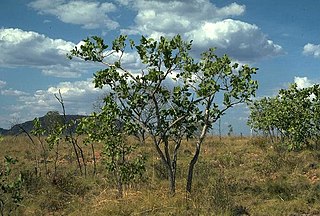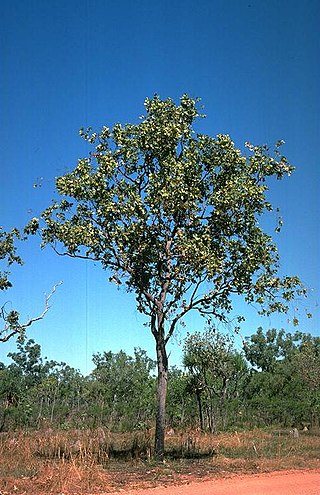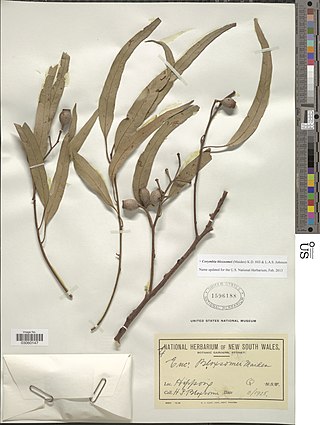
Corymbia terminalis, also known as tjuta, joolta, bloodwood, desert bloodwood, plains bloodwood, northern bloodwood, western bloodwood or inland bloodwood, is a species of small to medium-sized tree, rarely a mallee that is endemic to Australia. It has rough, tessellated bark on some or all of the trunk, sometimes also on the larger branches, smooth white to cream-coloured bark above, lance-shaped adult leaves, flower buds in groups of seven, white flowers and urn-shaped fruit.

Corymbia zygophylla, commonly known as the Broome bloodwood, is a species of small tree or a mallee that is endemic to Western Australia. It has rough, tessellated to fibrous bark on the trunk and branches, a crown of juvenile heart-shaped to lance-shaped, stem-clasping leaves, flower buds in groups of three or seven, white flowers and urn-shaped to shortened spherical fruit.

Corymbia abbreviata, also known as scraggy bloodwood, is a species of straggly tree that is native to Western Australia and the Northern Territory. It has rough bark, a crown of stiff leaves arranged in opposite pairs, flower buds usually in crowded groups on the ends of branchlets and urn-shaped fruit.

Corymbia arenaria, commonly known as bundah bundah or black bloodwood, is a species of tree that is endemic to the northern Kimberley region of Western Australia. It has rough bark on the trunk and branches, lance-shaped to curved adult leaves, flower buds in groups of seven, white flower and spherical urn-shaped fruit.

Corymbia chippendalei, commonly known as sand-dune bloodwood or sandhill bloodwood, is a species of small tree or a mallee that is endemic to desert country in central Australia. It has rough bark on part or all of the trunk, lance-shaped adult leaves, flower buds in groups of seven, white flowers and shortened spherical fruit.

Corymbia cliftoniana is a species of tree that is endemic to northern Australia. It has thick, rough, tessellated bark on the trunk and branches, narrow lance-shaped adult leaves, flower buds in groups of seven, creamy white flowers and shortened spherical fruit.

Corymbia collina, commonly known as silver-leaved bloodwood, is a species of tree that is endemic to Western Australia. It has thin patchy rough bark on some or all of the trunk, smooth white to pale grey bark above, lance-shaped to curved adult leaves, flower buds in groups of seven, creamy white flowers and barrel-shaped fruit.

Corymbia confertiflora, commonly known as broad-leaved carbeen or rough leaf cabbage gum, is a species of tree that is endemic to northern Australia. It has rough, tessellated bark near the base of the trunk, smooth white to pale grey bark above, a crown of both intermediate and adult leaves, large numbers of flower buds borne on leafless sections of branchlets in groups of seven, creamy white flowers and cylindrical to barrel-shaped or bell-shaped fruit.
Corymbia deserticola is a species of straggly tree, a mallee or a shrub that is native to Western Australia and the Northern Territory. It has rough, tessellated bark on the trunk and branches, mostly sessile, heart-shaped leaves arranged in opposite pairs, flower buds in groups of seven on each branch of a peduncle, creamy yellow flowers and urn-shaped to shortened spherical fruit.

Corymbia eremaea, commonly known as mallee bloodwood, hill bloodwood and Centre Range bloodwood, is a small, mallee-like tree that is endemic to central Australia. Indigenous Australians know the plant as muur-muurpa. It has rough, evenly tessellated bark, lance-shaped leaves, oval to pear-shaped flower buds arranged on a branching peduncle and urn-shaped fruit.

Corymbia erythrophloia, commonly known as red bloodwood, variable-barked bloodwood, red-barked bloodwood or gum-topped bloodwood, is a species of tree that is endemic to Queensland. It has rough bark on the trunk and branches, egg-shaped or lance-shaped adult leaves, flower buds in groups of seven, creamy white flowers and urn-shaped to spherical fruit.

Corymbia ferriticola, commonly known as Pilbara ghost gum, is a species of tree or a mallee that is endemic to Western Australia. It has smooth bark, lance-shaped adult leaves, flower buds in groups of seven, creamy white flowers and shortened spherical to cylindrical fruit.

Corymbia ferruginea, commonly known as rusty bloodwood, is a species of tree that is endemic to northern Australia. It has rough, tessellated bark on the trunk and branches, a crown of sessile juvenile leaves, flower buds in groups of three or seven, pale creamy yellow flowers and urn-shaped fruit.

Corymbia foelscheana, commonly known as broad-leaved bloodwood, fan-leaved bloodwood or smooth-barked bloodwood, is a species of small tree that is endemic to northern Australia. It has thin, rough, tessellated bark on some or all of the trunk, smooth bark above, broadly egg-shaped to broadly lance- shaped adult leaves, flower buds usually in groups of seven, creamy white flowers and urn-shaped fruit.

Corymbia bloxsomei, commonly known as yellowjack, yellow jacket or yellow bloodwood, is a species of tree that is endemic to inland, south-eastern Queensland. It has thick, rough scaly bark on the trunk and larger branches, lance-shaped or curved adult leaves, flower buds in groups of seven, nine or eleven, creamy white to pale yellow flowers and barrel-shaped, urn-shaped or spherical fruit.
Corymbia lamprophylla, commonly known as shiny-leaved bloodwood, is a species of tree that is endemic to central Queensland. It has rough, tessellated bark on the trunk and larger branches, lance-shaped adult leaves, flower buds in groups of seven, creamy white flowers and urn-shaped fruit.
Corymbia petalophylla is a species of tree that is endemic to Queensland. It has rough, tessellated bark on the trunk and branches, lance-shaped or curved adult leaves, flower buds in groups of seven, white flowers and barrel-shaped, urn-shaped or shortened spherical fruit.
Corymbia porrecta, commonly known as grey bloodwood, is a species of small tree that is endemic to the Northern Territory. It has rough, tessellated bark on the trunk and branches, broadly lance-shaped to egg-shaped adult leaves, flower buds usually in groups of seven, creamy white flowers and urn-shaped to barrel-shaped fruit.
Corymbia scabrida, commonly known as rough-leaved yellowjacket, is a species of small tree that is endemic to central Queensland. It has rough, tessellated bark on the trunk and branches, a crown of juvenile and intermediate leaves, flower buds in groups of seven, white flowers and barrel-shaped to urn-shaped or shortened spherical fruit.

Corymbia setosa, commonly known as rough leaved bloodwood or desert bloodwood, is a species of small tree that is endemic to north-eastern Australia. It has rough, tessellated brown bark on the trunk and branches, a crown of juvenile, heart-shaped leaves arranged in opposite pairs, flower buds in groups of three or seven, white flowers and urn-shaped to shortened spherical fruit.














